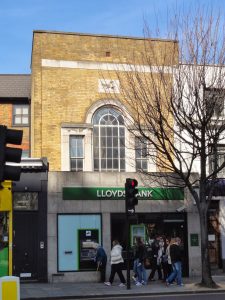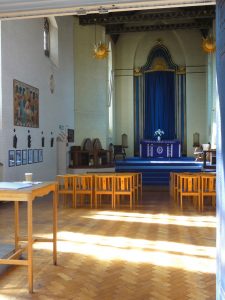Sir Edward Maufe (1883-1974) is most famous for his Guildford Cathedral, but he made a significant impact on London too. This is Heal’s Department Store on Tottenham Court Road.
Edward Maufe – Lloyds Bank, 50 Notting Hill Gate, London (1930)
Banks have long made a point of building their branches to look solid; faced with stone they are often the most imposing building on the high street, suggesting to their customers that their savings are safely hidden behind strong walls. Maufe undertook several commissions for Lloyds Bank, of which 50 Notting Hill Gate is widely held to be the best – although sadly defaced with a modern front. Here is an alternative design he proposed – rather grander than the stock-brick building they eventually built.


Edward Maufe – St Saviour’s Old Oak Road, Acton (1926)
This quite plain church was built for the Royal Association of the Deaf and Dumb. Built from brick, in simplified Gothic style, it was regarded as being in Swedish style on account of that simplicity. The church is locally listed, and was sold during 2014. Interestingly it was built with the church floor raked, in order to make the priest more visible to the congregation and to make reading sign language easier. Although not perceptible from the photograph there is an alarming slope to the floor.



Edward Maufe – St Columba’s Pont Street (1955)
Built for the Scottish Presbyterian Church to replace a church that was destroyed by enemy action during the war, this is unusual in being built from stone. It’s very handsome, being built to make full use of the restricted site – with a church hall in the basement. Again, note the distinctive drain pipes, and the carvings above the doors. The sculpture is St Columba standing in his coracle, by Vernon Hill.





The foundation stone is extensive and handsome, and the stone below is signed by Maufe (in the bottom left-hand corner of this picture).
Part two of this tour is to be found at An Architectural Tour of Maufe’s London – Part 2.








